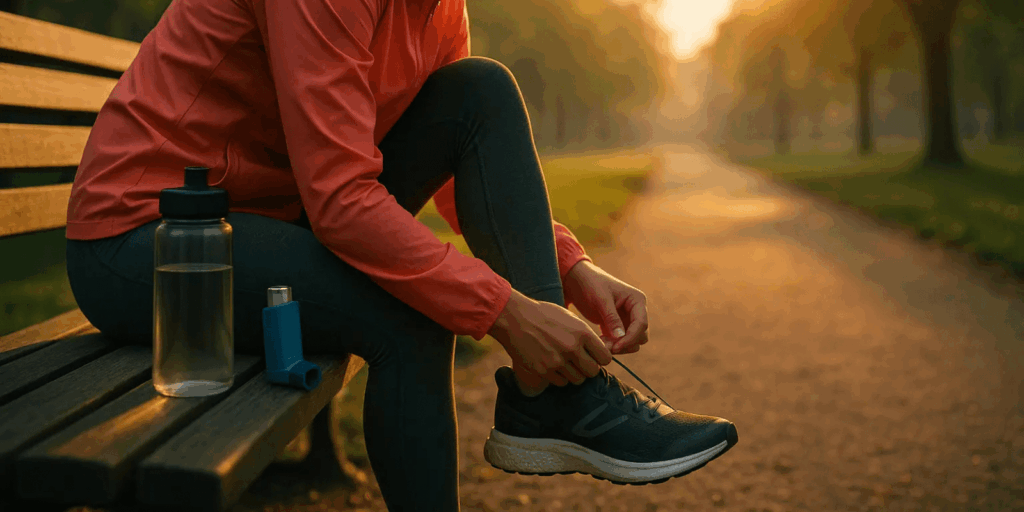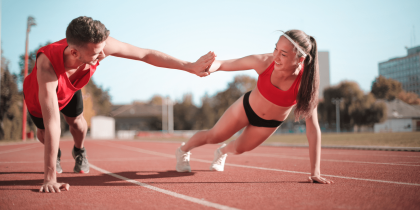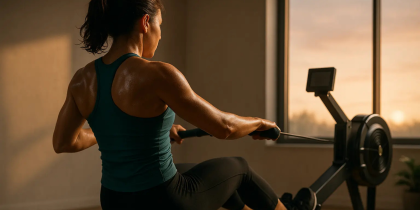Do you think asthma prevents you from doing sport? Think again! Asthma and sport can coexist: regular physical activity strengthens the respiratory muscles, reduces attacks, and improves mental well-being. Olympic champions such as Paula Radcliffe and David Beckham have proven it. Discover the recommended sports (swimming, yoga, brisk walking), the pitfalls of exercise-induced asthma (cold air, chlorine), and how to create a personalised action plan with your doctor for safe practice. This guide helps you balance health benefits with the right precautions, for confident and safe physical activity.
Asthma and sport: are they really incompatible?
Are you asthmatic and afraid to exercise? You should know that regular physical activity is not only possible but beneficial for respiratory health. According to a study, 65% of asthmatics engage in weekly physical activity — a higher rate than non-asthmatics (61%).
Far from being an obstacle, suitable training strengthens the respiratory muscles, improves lung capacity, and reduces attacks. However, 43% of people with severe asthma see sport as a source of anxiety, and 16% avoid any physical activity throughout the year.
This article explores the benefits of sport for asthmatics, the precautions to take, the recommended sports, and the mistakes to avoid. By combining medical advice and the experiences of top athletes like Justine Henin, discover how to turn asthma into an ally for your physical fitness.
Tip: Controlled asthma opens the door to an active life. Don’t let misconceptions limit your potential!
The unsuspected benefits of physical activity for asthmatics
Physical activity, long avoided by asthmatics, is now recognised as an essential pillar in managing the condition. Regular practice strengthens respiratory muscles and improves lung capacity. Exercises such as swimming, in a warm and humid environment, prevent irritation caused by dry air while optimising lung ventilation.
Endurance sports increase effort tolerance, reducing breathlessness in daily life. The diaphragm and intercostal muscles become more efficient, allowing smoother breathing. This physical adaptation makes it possible to perform activities without triggering attacks.
Psychological well-being is also transformed. The reduction of stress and anxiety through endorphins lowers attack triggers. This mental improvement boosts self-confidence and normalises the perception of asthma as a manageable challenge.
Respiratory physiotherapy complements these benefits. Targeted exercises, such as diaphragmatic breathing, help clear the bronchi and regulate hyperventilation. These techniques, combined with appropriate activity, create a virtuous cycle for respiratory health.
Medical follow-up remains crucial. A personalised plan, combined with proper warm-ups and environmental precautions (pollution, cold), ensures safe practice. For example, adjusting training according to air quality or using a face cover in winter protects the airways.
Understanding exercise-induced asthma to better control it
What is exercise-induced asthma?
Exercise-induced asthma (EIA), or exercise-induced bronchoconstriction (EIB), causes temporary narrowing of the bronchi during or after physical exertion. It affects asthmatics but can also occur in people without chronic asthma, under the name EIB. Both forms react to the same triggers: cold, dry, or polluted air. The prevalence of EIA is estimated at 8–10% in the general population but can reach 20% among athletes. Regular medical monitoring is crucial to adapt treatments and prevent attacks, especially for frequent exercisers.
What are the causes and symptoms?
Hyperventilation during exertion dries and cools the airways, activating inflammatory mediators (e.g. leukotrienes) that constrict the bronchi. Two theories explain this phenomenon: the thermal theory (cooling of the airways) and the osmotic theory (dehydration of the bronchial epithelium). Aggravating factors include cold, dry air, pollution, allergens (pollen), and chlorine from swimming pools — a common irritant for swimmers. Pollen, worsened by pollution, often triggers attacks, especially during pollination periods (January–March for trees, spring for grasses, July–September for weeds in France).
Typical symptoms:
- Dry cough after exercise, often after running
- Wheezing during or after activity
- Chest tightness limiting inspiration
- Shortness of breath disproportionate to the effort
- Unexplained fatigue linked to poor oxygenation
They appear 5 to 10 minutes after starting exercise or immediately after. A personalised prevention plan (preventive treatment, proper warm-up) is essential. Simple actions, such as inhaling through the nose to humidify air or avoiding polluted environments, reduce risk. For allergy sufferers, a doctor may recommend antihistamines during peak pollen periods for better exercise tolerance.
Practical guide: choosing your sport when you have asthma
Asthmatics can practise sport, but some choices are wiser than others. The key? Adapting the activity to your health, considering intensity, environment, and medical precautions.
| Recommended sports | Sports to practise with precautions | Sports to avoid |
|---|---|---|
| Swimming (prefer pools with low chlorine), brisk walking, hiking, moderate cycling, yoga, gentle martial arts, dance, slackline | Running, trail, football, basketball, cross-country skiing, skating | Scuba diving, horse riding (if allergic to hair or hay) |
Recommended sports strengthen respiratory muscles without exposing you to triggers. Swimming, for example, improves lung capacity thanks to the humid pool air, but chlorine can irritate the airways. The solution? Choose pools using alternative disinfection systems (copper-silver). Yoga and slackline, on the other hand, help control breathing.
Sports to practise with precautions require strict medical supervision. Intense efforts (running) or exposure to cold air (cross-country skiing) increase the risk of bronchoconstriction. A 15-minute warm-up and the use of a bronchodilator before exercise are recommended. In winter, a face mask or scarf can help warm inhaled air.
Finally, sports to avoid, such as scuba diving, present vital risks. The pressure and dry air from tanks can cause pulmonary overpressure during ascent. Medical advice is essential, including tests such as dry-air stress tests. Horse riding, for those allergic, can also trigger attacks due to dust or hay.
For everyone, a personalised prevention plan is essential. Regular follow-up with an allergist helps adjust treatment (inhaled corticosteroids, leukotriene antagonists) and monitor exposure to allergens or pollution. By combining proper preparation and informed choices, sport remains a valuable ally for respiratory health.
Essential precautions for safe physical activity
Before exercise: preparation
To practise sport safely, asthma must be well controlled. Follow your maintenance treatment prescribed by a doctor, even if symptoms are absent. A progressive warm-up of at least 15 minutes helps your bronchi adapt to exertion. If prescribed, use a bronchodilator (such as Ventolin) 10 to 15 minutes before activity, according to your personalised plan.
Check environmental conditions: avoid pollution, pollen peaks, or cold. These aggravating factors can trigger an attack. Good preparation reduces risks by 70%, according to medical recommendations.
During exercise: listening to your body
Breathe through your nose to warm and humidify the air, avoiding bronchial irritation. Stay hydrated regularly to prevent dryness in the airways. Adjust the intensity of your effort based on how you feel: never push through discomfort. Studies show that proper hydration reduces bronchospasm risk by 40% during exercise.
After exercise: cooling down
A 10-minute cooldown phase, including stretching or gentle walking, prevents abrupt cessation of effort. Monitor symptoms in the following hours, especially a dry cough or unusual breathlessness — signs of poorly controlled asthma.
Golden rules:
- Always carry your rescue treatment
- Never push through discomfort — stop if needed
- Inform your coach or teammates about your condition
These expert-approved rules prevent 90% of exercise-related attacks. Regular medical monitoring remains crucial to adapt your training to the evolution of your asthma.
What to do in case of an asthma attack during sport
An asthma attack can occur even with thorough preparation. The “Rule of 4”, named after its four steps, provides a clear emergency protocol. It combines immediate actions with adaptation to environmental conditions.
Apply the Rule of 4 in case of an attack
- Stop exercising immediately and sit down to reduce respiratory demand. Proper warm-up helps prevent attacks by preparing the bronchi for exertion.
- Take 4 puffs of your rescue bronchodilator (such as Ventolin), one at a time, with a 1-minute interval between each. This opens the bronchi and restores airflow, allowing time between doses for better absorption.
- Wait 4 minutes to assess effectiveness. Slow breathing through the nose helps you stay calm.
- Repeat 4 puffs and call emergency services (999 or 112) if symptoms persist. Cold or pollution can worsen attacks, requiring rapid intervention.
Regular medical follow-up adjusts treatments and helps design a personalised prevention plan adapted to climate and allergen conditions. In case of an attack, stay calm, inform someone nearby or your coach, and always keep your inhaler within reach.
Asthma, elite sport, and doping: a specific challenge
Did you know elite athletes are 1.9 times more likely to have asthma?
An underestimated epidemic among champions
16.5% of European Olympic athletes suffer from asthma or EIB, peaking at 55% in endurance sports. Winter sports (cross-country skiing), swimming in chlorinated pools, and intense training (>20h/week) worsen symptoms. Repeated hyperventilation of cold or polluted air damages the airways.
Pathophysiological mechanisms: between theory and reality
Main causes:
- Thermal theory: Cooling and dehydration of the airways followed by post-exercise warming cause oedema and bronchoconstriction.
- Osmotic theory: Dry air creates a hyperosmolar environment that releases inflammatory mediators.
- Epithelial microtrauma: Mechanical stress from hyperventilation activates mast cells and neutrophils.
For some athletes, inflammation can subside after stopping intense training.
Anti-doping: balancing medical necessity and strict controls
Regulations govern inhaled treatments:
- Allowed without restriction: inhaled corticosteroids and leukotriene antagonists.
- Below limit: Salbutamol (max 1600µg/24h), Formoterol, and Salmeterol.
- Requiring a Therapeutic Use Exemption (TUE): oral corticosteroids and non-inhaled beta-2 agonists.
The TUE process requires a full lung assessment (spirometry, challenge tests) and strict medical follow-up.
Inspiring examples of asthmatic athletes
Paula Radcliffe (marathon) and David Beckham (football) overcame their asthma. Amy Van Dyken, a quadruple Olympic medallist, turned her asthma into a strength by mastering her breathing. Their success illustrates the effectiveness of TUEs and adapted environments (outdoor pools, fresh air).
Environment: a determining factor
Exposure to chlorine, pollutants, or cold worsens symptoms. A progressive warm-up and personalised follow-up are essential for safe practice.
Asthma is not a barrier to sport if properly managed medically. Adapted activity with a personalised plan provides both respiratory and psychological benefits. By following precautions, choosing suitable sports, and knowing what to do in case of a crisis, asthmatics can improve their quality of life and thrive fully.



